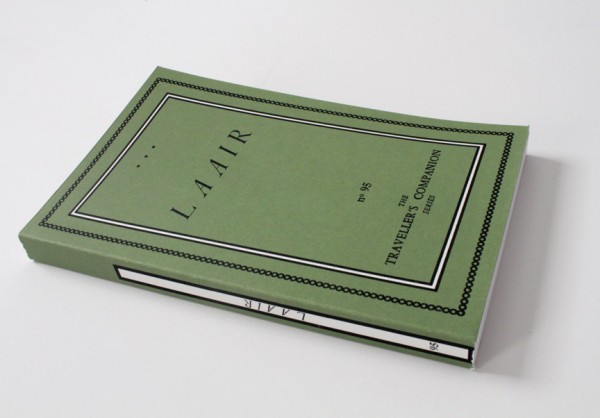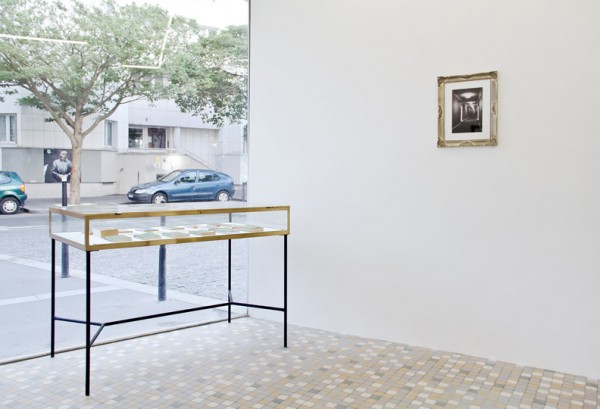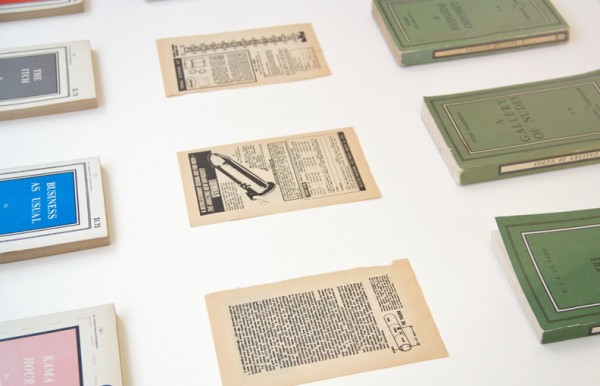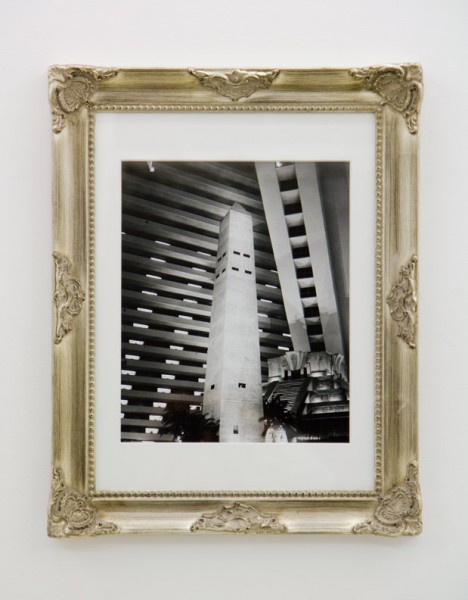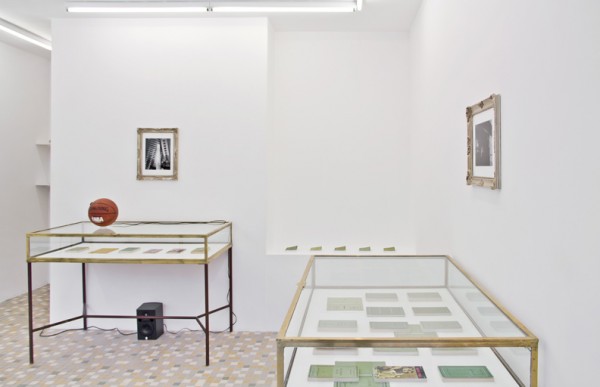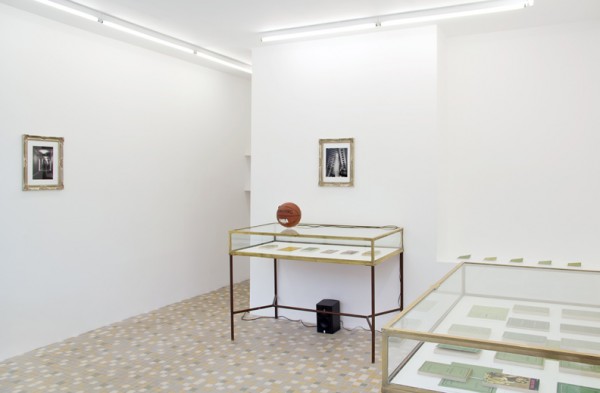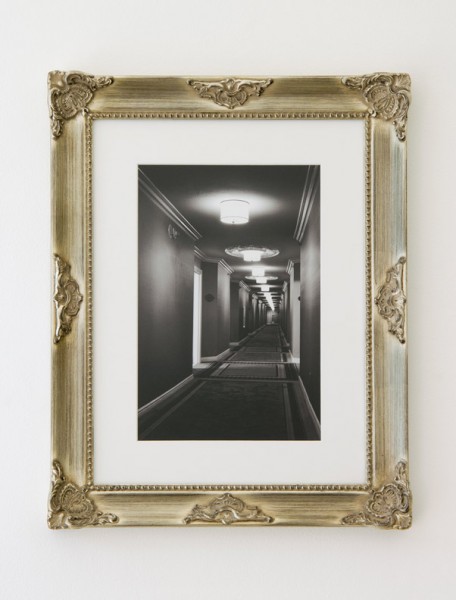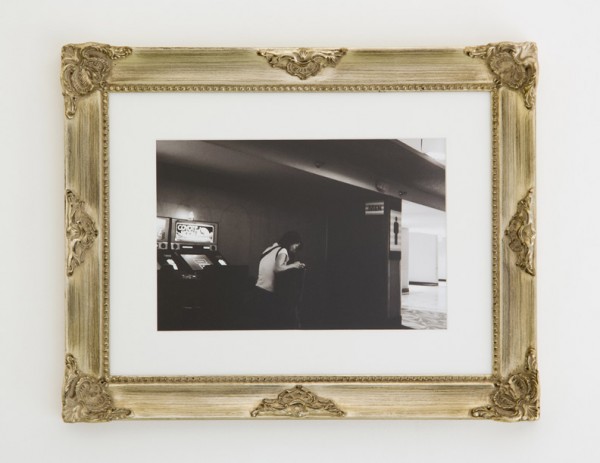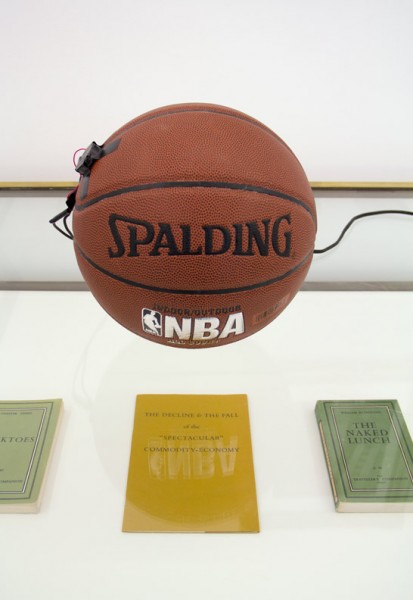LAAIR / Traveller’s Companion Addenda at Shanaynay Paris
LAAIR/Air de Paris, live performance at Shanaynay, Paris, 2013
LAAIR / Traveller’s Companion Addenda solo show opens June 29, 2013
Maurice Girodias’ Olympia Press was the publisher simultaneously of seminal 20th Century avant-garde literature -including Naked Lunch and Lolita- and of the lowest sleaze -sensational confessionals and pornography- in Paris in the 1950’s and 60’s. Often the pornography and sensational confessionals were written pseudonymously by members of the avant-garde including George Bataille (Pierre Angelique), Jean Cocteau, and William S. Burroughs (William Lee). Jean Genet, Henry Miller, and Samuel Beckett published then-controversial texts now considered artistic watersheds under their own names. The gamut of titles was incoherent, bizarre, predicated on the whims of Girodias- himself pseudonymous (he changed his name to evade the Nazis), a sort of auteur who seemed to make decisions based on the influence of others mixed with the weirdness of his own taste and questionable business acumen.
The press itself contained an impossible paradox: an English-language press in based Paris with its books banned in the U.S. and Britain, Olympia catered to an audience of the displaced, the expatriate, outcast intellectuals, and the perverse and occupied a complex and ambiguous position later to descend into full embattlement resulting from multiple obscenity trials. It existed at the center of a matrix of concerns, monetary primalily, but also stylistic, rife with individual obfuscations and obliterations, self-creation, and taboo-shattering. It was a press without an audience, without a clear agenda, authored by pseudonymous, often sophisticated writers slumming it. According to Iris Owens (pseudonym Harriet Daimler), the one taboo was necrophilia- all else was fair game.
Collectors Publications in Covina, California- a suburb of Los Angeles- pirated and republished much of the Olympia Catalog in the United States, as well as Joyce’s Ulysses (complete with penis enlargement ads), in bright-colored variations on Olympia’s green wraps. Evading the regular burnings by the U.S. Postal Service of imported banned books, the owner was later convicted of obscenity charges and entire areas of U.S. First Amendment law were predicated on the “Miller test” of whether “community standards” deemed the material to be “of prurient interest”.
The spare graphic style of Olympia’s Traveller’s Companion Series was precursor to that of many other ‘d.b.”s (‘Dirty Books’ in Girodias’ formulation) as well as the minimally-inflected style of early conceptual artists: The pseudonymity, the modernist approaches to text employed by Burroughs, Beckett, and others, the simple font, and the stripped down, endlessly repeated cover layout were all precursors to the aesthetic of minimalist and conceptual art. The Olympia aesthetic inflected the work of West Coast conceptualist and proto-conceptualist book-makers including Wallace Berman, Ed Ruscha, Bruce Nauman, and Guy de Cointet.
CLASSICAL HINDU EROTOLOGY- Swami Ram Krishnananda, pseudonymously authored
SATYR TREK- Ray Kainen, published following Olympia’s move to New York, a near-anagram capitalizing on the erotic possibilities of Star Trek, ‘a sexy Space/Time trip…’
SCUM (Society for Cutting Up Men) MANIFESTO- Valerie Solanas, the Olympia press edition was published by Girodias after Solanas shot Andy Warhol. The cover design’s grid of repeated black and white images of the author is clearly meant to evoke Warhol’s work of the time.
FUZZ AGAINST JUNK- Akbar Del Piombo (Norman Rubington). Collages by Rubington, an expatriate American painter, in the early style of Max Ernst. The collages here all
TELENY or The Reverse of the Medal- Anonymous. Gay Erotica thought to have been authored by Oscar Wilde. Possibly a collaboration between Wilde and others.
WOMAN- Harriet Daimler- (Iris Owens) Iris Owens was a young writer in Paris offered 500 fr by Girodias to write
THE PLEASURE THIEVES- Harriet Daimler and Henry Cranach (Iris Owens and ?)- one of Olympia’s best-selling
MY LIFE AND LOVES- Frank Harris (Alexander Trocchi). Trocchi, involved with Merlin and other Paris-based literary journals, initially resisted Girodias offer to write smut and went on to write this, one of Olympia’s most-reprinted sleaze titles.
SEXTET- J. Hume Parkinson
THE BEDROOM PHILOSOPHERS- D.A.F. DeSade, translated by Pierallesandro Casavini (Austryn Wainhouse) Wainhouse translated DeSade for Olympia and others before writing his obscure novel Hedyphagetica
A BEDSIDE ODYSSEY- Homer and Associates (Michel Gall), an eroticisation of the Odyssey, a sleazy takeoff on Joyce’s Ulysses
LAAIR , 1970. Bruce Nauman’s artist’s book of photographs of the ‘poisoned air’ of Los Angeles.
ACR CIT, 1971, Guy de Cointet (Dr. Hun).Newspaper written in code distributed free around Los Angeles..
LA CONFIDENCE SENSUELLE, 1951, Andre Suffren (Isadore Isou). Lettriste movement founder and proto-Situationist Isou’s pseudonymous attempt at transgender erotica. Republished by the Olympia Press and pirated by Collectors Publications as Diary of the Senses by Helen Butler.
HBFAIRY, 1968. The CIA cryptonym for France. HAK HARVAN and FLOWER are the cryptonyms for the players behind U.S Presidential candidate Richard Nixon’s 1968 subversion of the Paris peace talks for Vietnam. As a result of the intervention of Henry Kissinger (HAK) and Anna Chennault (FLOWER), South Vietnam withdrew from the talks and Nixon won the election..
UN COUP DE DES JAMAIS N’ABOLIRA LE HASARD, 1969. Marcel Broodthaers artist’s book reworking of Mallarme’s poem replacing the words with black stripes corresponding to the layout of the text,
De Nuit
Mid-20th Century Paris-based Hungarian expatriate photographer Brassai’s circle included core members of the avant-garde as well as the denizens of the nightlife and illicit activity. Associated with Dali, Picasso, and Olympia regulars Henry Miller (Brassai was the model for Miller’s companion in Tropic of Cancer), Jean Genet, and others, his nighttime photographs addressed the dark side of Parisian life and its inhabitants: pimps, prostitutes, gangsters, gamblers- and became both an important contribution to the genre of ‘street photography’ and an influence on the nascent film noir.
For the series De Nuit, Benzel photographs Paris, Vegas and the Luxor (reflecting 19th century Paris’ Egyptophilia) in the manner of Brassai: at night, with a small-plate camera on tripod, long exposures on black and white film, and, in same cases, a flash fired with the shutter fixed open- with markedly different results.
Brassai’s signature shots of Paris by night are altered by the eternal twilight that is the interior of the Las Vegas hotel-casino and the pulchritudinous exterior lighting that turns the building and its simulacrum of Paris literally into a sign for (overwrought) sensual pleasure, (false) glamour, and fantasies of excess.
Las Vegas’ own not-so-hidden history of gangsters, pimps, prostitutes, is subsumed by spectacle and sanitized by the anxieties of corporations working to attract middle-class families through their fantasies. Paris, Vegas by night is a cleaned up, neutered ghost of Brassai’s Paris and of the historical Las Vegas.
